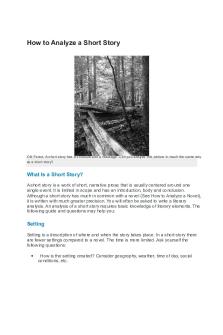\"Lenten ys come with love to toune\" - a short critical analysis. PDF

| Title | \"Lenten ys come with love to toune\" - a short critical analysis. |
|---|---|
| Course | Certificate of Higher Education |
| Institution | University of Oxford |
| Pages | 2 |
| File Size | 67.7 KB |
| File Type | |
| Total Downloads | 48 |
| Total Views | 117 |
Summary
Assignment One of University of Oxford Continuing Education Department's course "Middle English Literature"...
Description
"Lenten ys come with love to toune" - a short critical analysis. Structure Heavily structured. Very appropriate for a whirling dance, for accompanying on drums, tambourines etc, or for memorising before declaiming or singing: • Three stanzas of 12 lines each. • Each divided in to 4 triplets. • Rhyme scheme AAE, BBE, CCE, DDE. • 4 stresses in each couplet (first two lines of triplet) * 3 stresses in each third line of triplet. • Combination of dactyls and trochees, giving each line a strong 4/3-beat stress, akin to a foot-tapping dance rhythm, especially when the metrical pulse continues from one line to the next (metrical enjambment?) • There is alliteration in every single line. • The theses fall often on the initially alliterated syllables: 4 stresses/theses: — u u /— u u / — u u / — u / (enjambment of pulse here?) Lenten is come with loue to toune, u / — u / — u / — u / — u / (enjambment of pulse here?) 4 stresses/theses: With blosmen ant with briddes roune, u / — u /— u / — u 3 stresses/theses: That al this blisse bryngeth. etc. Questions on Imagery, Theme, Subject • First six lines draw heavily on first six lines of The Thrush and the Nightingale. The same vocabulary. The same alliterations. Why? • Reverdie is extended further than normal, love complaint introduced much later than normal - first mentioned in line 21 in a 36-line poem. Why? • Is it common or even appropriate to attach the final hint of a lover's complaint so abruptly to the extended, two and a half stanza reverdie? Answers • The speaker’s personality and inner frustration is being projected ironically onto the superficial, joyous birdsong of all the earlier nature imagery? Unlikely but possible. This is too much an 18th or 19th century view - when the romanticism of the interior world of Rousseau's noble savage, e.g. Emile going back to nature, was all too painfully explicit and prevalent. Too anachronistic an interpretation.
• The speaker is toying cataphorically with his audience - naming his most important thought - the moral - of this poem as late as possible? Unlikely but possible. This suggests a clumsy combination of commonplace tropes: a self-indulgent riff on clichéd themes. Conclusion • Lenten is a riddle, harking back to Old English riddles, naming their solution/theme at the end, as an explanatory punch line. • The audience is initially puzzled by reference to a well-known poem, expects a reveal of the first-person speaker and his expected attitude, but is met with a perplexing extension of the reverdie. • This elaborates the antitheses of the age-old "querelle des femmes" trope, as debated in The Thrush and the Nightingale. (Howell 1980) Debating begins at line 7 in both poems. Explicit in The Thrush, it is much more subtle in Lenten, merely referencing each bird in the other poem with the same vocabulary: "threstelcoc" for the misogynist and "nythegales/nightingale" for the philogynist. • The antithetical estrif of The Thrush is replayed, enlarged and ultimately explained to the audience in the repetitive dance-like riddle that is Lenten.
Howell, A. J. (1980). "Reading the Harley Lyrics: A Master Poet and the Language of Conventions." ELH 47(4): 619-645....
Similar Free PDFs

Critical Analysis
- 6 Pages

Big Love Analysis Brief
- 3 Pages

A come Architettura
- 5 Pages

Come andare a capo
- 2 Pages

How to Analyze a Short Story
- 8 Pages
Popular Institutions
- Tinajero National High School - Annex
- Politeknik Caltex Riau
- Yokohama City University
- SGT University
- University of Al-Qadisiyah
- Divine Word College of Vigan
- Techniek College Rotterdam
- Universidade de Santiago
- Universiti Teknologi MARA Cawangan Johor Kampus Pasir Gudang
- Poltekkes Kemenkes Yogyakarta
- Baguio City National High School
- Colegio san marcos
- preparatoria uno
- Centro de Bachillerato Tecnológico Industrial y de Servicios No. 107
- Dalian Maritime University
- Quang Trung Secondary School
- Colegio Tecnológico en Informática
- Corporación Regional de Educación Superior
- Grupo CEDVA
- Dar Al Uloom University
- Centro de Estudios Preuniversitarios de la Universidad Nacional de Ingeniería
- 上智大学
- Aakash International School, Nuna Majara
- San Felipe Neri Catholic School
- Kang Chiao International School - New Taipei City
- Misamis Occidental National High School
- Institución Educativa Escuela Normal Juan Ladrilleros
- Kolehiyo ng Pantukan
- Batanes State College
- Instituto Continental
- Sekolah Menengah Kejuruan Kesehatan Kaltara (Tarakan)
- Colegio de La Inmaculada Concepcion - Cebu










